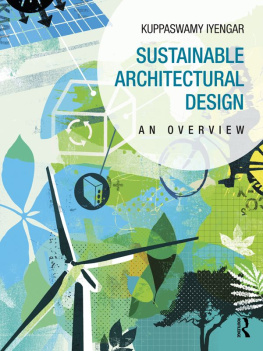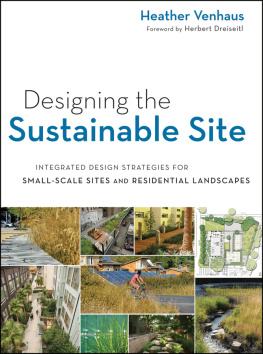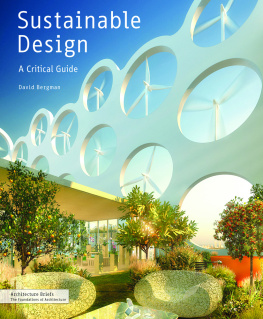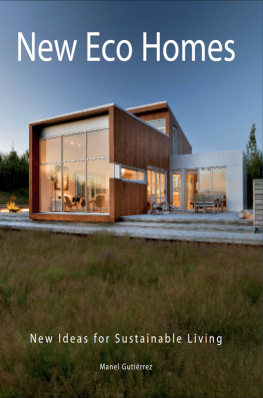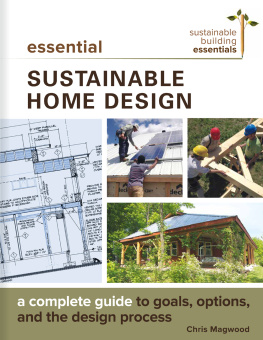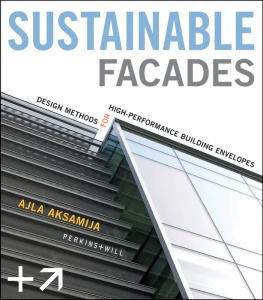Sustainable Architectural Design
This book is a guide to a sustainable design process that moves from theory, to site and energy use, to building systems, and finally to evaluation and case studies, so you can integrate design and technology for effective sustainable building. Kuppaswamy Iyengar shows you how to get it right the first time, use free energy systems, and utilize technologies that minimize fossil fuel use. Each chapter has a sustainable design overview, technical details and strategies marked by clear sections, a summary, and further resources. Heavily illustrated with charts, tables, drawings, photographs, and case studies, the book shows technologies and concepts integrated into cohesive project types, from small and large office spaces to single and multi-use residences, hospitals, schools, restaurants, and warehouses to demonstrate implementing your designs to meet clients needs now and for the future.
This book includes an overview of alternative assessment and evaluation systems such as BREEAM, CASBEE, GBTool, and Green Globes, alongside LEED, ECOTECT, energy 10, HEED, and eQuest simulation programs. The guide reveals the importance of the building envelope walls, superstructure, insulation, windows, floors, roofs, and building materials for the environmental impact of a building, and has a section on site systems examining site selection, landscape design, thermal impact, and building placement.
Kuppaswamy Iyengar is an Associate Professor, Associate Director, and Regents Lecturer in the architecture program at the University of New Mexico. Professor Iyengar is a highly skilled teacher and technical consultant, combining his degrees in civil and structural engineering and architecture with over fifty years practical experience. In addition to developing academic courses of study, he has designed and presented over 50 seminars in professional settings, bringing his expertise to students in academic, governmental, and commercial locations in India, Barbados, the USA, England, Canada, Australia, the Philippines, and Thailand.
Sustainable Architectural Design
An Overview
Kuppaswamy Iyengar
First published 2015
by Routledge
711 Third Avenue, New York, NY 10017
and by Routledge
2 Park Square, Milton Park, Abingdon, Oxon OX14 4RN
Routledge is an imprint of the Taylor & Francis Group, an informa business
2015 Taylor & Francis
The right of Kuppaswamy Iyengar to be identified as author of this work has been asserted by him in accordance with sections 77 and 78 of the Copyright, Designs and Patents Act 1988.
All rights reserved. No part of this book may be reprinted or reproduced or utilized in any form or by any electronic, mechanical, or other means, now known or hereafter invented, including photocopying and recording, or in any information storage or retrieval system, without permission in writing from the publishers.
Trademark notice: Product or corporate names may be trademarks or registered trademarks, and are used only for identification and explanation without intent to infringe.
Every effort has been made to contact and acknowledge copyright owners, but the author and publisher would be pleased to have any errors or omissions brought to their attention so that corrections may be published at a later printing. Readers should be aware that local building codes and standards vary widely by region and may require verification and research.
Library of Congress Cataloguing in Publication Data
Iyengar, Kuppaswamy.
Sustainable architectural design : an overview / Kuppaswamy Iyengar.
pages cm
Includes bibliographical references and index.
1. Sustainable architecture. 2. Architectural design. I. Title.
NA2542.36.I94 2015
720.47--dc23
2014031955
ISBN: 978-0-415-70234-8 (hbk)
ISBN: 978-0-415-70235-5 (pbk)
ISBN: 978-1-315-75847-3 (ebk)
Acquisition Editor: Wendy Fuller
Editorial Assistant: Grace Harrison
Production Editor: Jennifer Birtill
Typeset in 10.5/13.5 pt Adobe Caslon
by Fakenham Prepress Solutions, Fakenham, Norfolk NR21 8NN
This book is dedicated to my beloved wife, Lalitha.
Contents
I thank many authors for their dedication to educating future designers in sustainable architecture and many others all over the world for creating awareness about global warming and its consequences. I owe them my profound gratitude.
Katherine Enggass, my editor, while never wavering in her support of this project, relentlessly verified my writing and made sure that I mostly got it right.
I owe my gratitude to Professor Stephen Dent at the University of New Mexico for thoroughly reviewing an earlier draft for technical content, and Professor Andrew Pressman at the University of Maryland for guiding in framing the book and generally supporting my effort. I thank UNM Adjunct Professor Lawrence Schuster for detailed review and advice on the HVAC section. I am responsible for any errors of omission and/or commission.
I am grateful to my students Norian Ubechel, UNM Architecture (2007), for helping me in researching the book material; Mathew Frantz, UNM Architecture (2009), and Christopher Murphy, UNM Architecture (2014), for drawing all the figures and tables in the book; and Sarah Sheesley, UNM Language Studies (2014), for her patient efforts in obtaining permissions.
I thank Routledge/Taylor Francis: to my commissioning editor, Wendy Fuller, for her vision and her support for this book, and to Laura Williamson, Emma Gadsden, and Grace Harrison for their tireless encouragement and editorial support.
If I missed anyone to thank here, I apologize it is not intentional.
Sustainable Architectural Design: An Overview aims to assist teachers and designers to plan and create buildings that meet the needs of the present without compromising the ability of future generations to meet their own needs []. This notion of preserving the planet for present and future generations poses several fundamental issues. Of primary concern is the interaction between natural systems (the regenerative capacity of the Earths biosphere) and human demands for natural resources. We humans are acting as though fresh resources will be discovered to satisfy our inexhaustible need, as if there is a second Earth waiting to provide for us when we run out of supplies. History reveals multiple examples alerting us that civilizations vanish when they out-strip their resources. Now we may be approaching just such a moment on a planetary level.
What is the response of the building and construction industry to these issues? Will the industry continue to contribute approximately 50 percent of greenhouse gas (GHG) emissions through its buildings as architect Edward Mazria contends []? Or will educators help designers learn how to make key sustainable decisions in the early stages of their projects, resolving to use passive and active green technologies to produce the least amount of carbon dioxide and other gases?
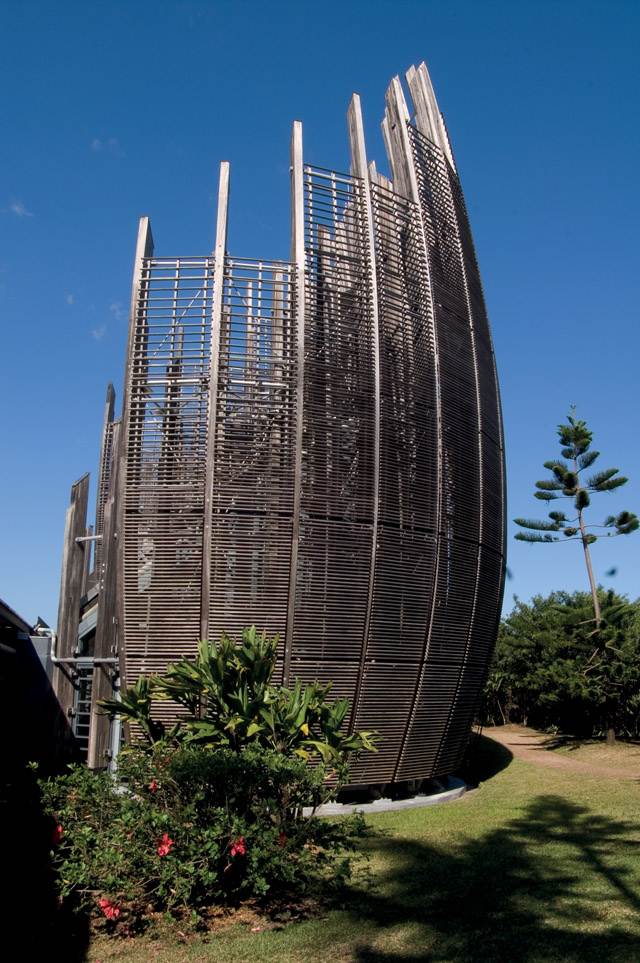

Jean Marie Tjibaou Cultural Center for Kanak Population, New Caledonia.
(Source: ADCK Centre Culturel Tjibaou/RPBW/Architects.)
Specifically, as a teacher, I am writing this book as a tool to meet challenges of my students to relate technical information to the studio design process, all within the context of sustainability. For designing sustainable (Net Zero or Net Plus) architectural buildings I recommend a three-step approach: (1) do it right first time through awareness of cultural and formal aesthetics, environmentally sound practices that take advantage of orientation, capturing the natural assets of the land, wind, and sun; (2) use free energy by understanding issues involved in sustainable design the site, building envelope, materials used, indoor air quality, water management, and minimizing waste following some of the LEED guidelines; and (3) minimize fossil fuel energy by using the most efficient technical systems possible.

